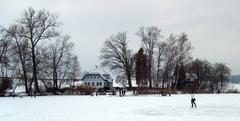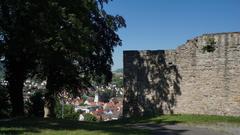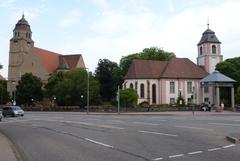Visiting Wallberg in Pforzheim: Hours, Tickets, and Travel Tips
Date: 19/07/2024
Introduction
Wallberg, located in Pforzheim, Germany, seamlessly blends historical significance with natural beauty. Often referred to as the ‘Gateway to the Black Forest,’ Pforzheim’s rich history dates back to Roman times. Wallberg itself has witnessed various historical epochs—from its origins as a strategic Roman site to its role in medieval fortifications and Renaissance developments. Over the centuries, Wallberg evolved into a hub for economic activity during the Industrial Revolution and endured significant changes during World War II. Today, it stands as a testament to Pforzheim’s resilience and cultural heritage. This guide aims to provide an extensive overview of Wallberg’s historical background, practical visitor information, travel tips, and highlights of nearby attractions, ensuring a well-rounded experience for all visitors (Pforzheim Tourism) (Pforzheim City Archives).
Table of Contents
- Introduction
- Early History and Origins
- Medieval Period
- Renaissance and Early Modern Era
- Industrial Revolution
- World War II and Post-War Reconstruction
- Modern Era and Cultural Significance
- Visitor Information
- Travel Tips and Nearby Attractions
- Preservation Efforts
- Notable Historical Figures
- Architectural Highlights
- FAQ
- Conclusion
Early History and Origins
Wallberg in Pforzheim has a history that dates back to ancient times. The region has been inhabited since the Roman era, serving as a strategic location for trade and military operations. The name ‘Wallberg’ is derived from the German words ‘Wall’ (rampart or fortification) and ‘Berg’ (mountain), indicating its historical significance as a fortified site.
Medieval Period
During the medieval period, Wallberg played a crucial role in the defense and administration of the region. Historical records from the 12th century mention a castle on Wallberg, which served as a residence for local nobility and a defensive stronghold. The castle was part of a network of fortifications that protected the surrounding villages and trade routes.
Renaissance and Early Modern Era
In the Renaissance period, Wallberg continued to be of strategic importance. The castle underwent renovations and expansions to enhance its defensive capabilities. By the 16th century, Wallberg had become a symbol of power and prestige for the ruling families of Pforzheim, and the area saw significant economic development with the establishment of markets and trade fairs.
Industrial Revolution
The Industrial Revolution brought significant changes to Wallberg and Pforzheim. The discovery of gold deposits in the Black Forest region led to a boom in the jewelry and watchmaking industries, earning Pforzheim the nickname ‘Goldstadt’ or ‘Golden City.’ Wallberg became a popular spot for villas and mansions by wealthy industrialists, offering panoramic views of the city and surrounding countryside.
World War II and Post-War Reconstruction
Wallberg was heavily affected by World War II, with many historical buildings damaged or destroyed. The post-war period saw extensive reconstruction efforts focused on preserving the historical and cultural heritage of the area. Wallberg was gradually restored, and new residential and recreational facilities were developed.
Modern Era and Cultural Significance
Today, Wallberg is a popular destination for both locals and tourists. The hill is home to several historical landmarks, including remnants of the medieval castle and 19th-century villas. The area is known for its scenic hiking trails and panoramic views of Pforzheim and the Black Forest. Wallberg’s historical significance is celebrated through cultural events and festivals.
Visitor Information
Visiting Hours
Wallberg is open to visitors year-round. Specific hours for tours and access to certain landmarks vary, so it’s recommended to check the official Pforzheim tourism website for the latest information.
Tickets
Entry to Wallberg’s hiking trails and general areas is free. However, some guided tours and special events may require tickets. Prices can vary, so please refer to the Pforzheim tourism site for current details.
Travel Tips and Nearby Attractions
Travel Tips
- Wear comfortable shoes for hiking, and bring water and snacks. Early morning or late afternoon visits offer the best light for photography.
Nearby Attractions
- Pforzheim Jewelry Museum: Showcasing the city’s rich history in jewelry and watchmaking.
- Black Forest Museum: Offering insights into the natural and cultural history of the Black Forest region.
- Vibrant Market Squares: Perfect for experiencing local culture and cuisine.
Preservation Efforts
Efforts to preserve Wallberg’s historical and cultural heritage are ongoing. Local authorities and heritage organizations work together to maintain and restore historical structures. Educational programs and guided tours are offered to promote Wallberg’s conservation.
Notable Historical Figures
Margrave Charles Frederick of Baden is a notable figure associated with Wallberg. His contributions to the economic and cultural growth of Pforzheim are commemorated through various monuments and historical sites.
Architectural Highlights
Wallberg is home to several architectural highlights, such as the remnants of the medieval castle with its fortified walls and towers, and the 19th-century villas with ornate facades and lush gardens. These buildings are important historical landmarks showcasing the region’s rich cultural heritage.
FAQ
- What are the visiting hours for Wallberg? Wallberg is open year-round, with specific hours for tours and landmarks varying. Check the official Pforzheim tourism website for details.
- How much are tickets to Wallberg? Entry is generally free, but some guided tours and events may require tickets. Refer to the Pforzheim tourism site for current prices.
- What are some nearby attractions? Nearby attractions include the Pforzheim Jewelry Museum, the Black Forest Museum, and the city’s market squares.
Conclusion
Wallberg in Pforzheim, Germany, is a remarkable destination that offers a rich tapestry of history, culture, and natural beauty. From its early origins in Roman times to its strategic importance during the medieval and Renaissance periods, Wallberg has played a significant role in shaping the region’s history. The Industrial Revolution further enhanced its prominence, transforming Pforzheim into the ‘Golden City’ due to its booming jewelry and watchmaking industries. Despite the devastation during World War II, Wallberg has been meticulously restored and continues to attract visitors with its scenic hiking trails, historical landmarks, and cultural events. Whether you are a history enthusiast, nature lover, or adventure seeker, Wallberg provides a unique experience that celebrates Pforzheim’s heritage and beauty. For more information, visit the official Pforzheim tourism website or the Black Forest Museum. Stay updated with the latest events and tips by following Pforzheim tourism on social media.
References
- City of Pforzheim. (n.d.). Pforzheim Tourism. https://www.pforzheim.de/
- Pforzheim City Archives. (n.d.). https://www.pforzheim.de/stadtarchiv.html
- Black Forest Museum. (n.d.). https://www.schwarzwaldmuseum.de





